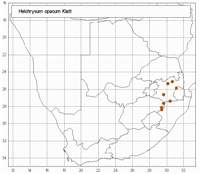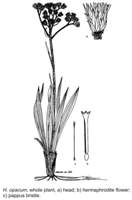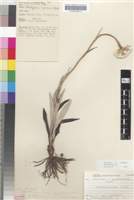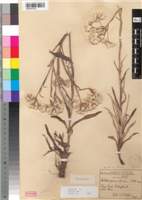Origin of name:
opacus = shady
Diagnostic characters:
White bractsLarge headsCompact branched inflorescence
Description:
Perennial herb, roots fusiform, crown clad in loose brown wool, flowering stem up to 400 mm high, nearly always solitary, thinly greyish-white felted, remotely leafy. Leaves mostly radical, up to c. 150 x 12 mm, lanceolate, only slightly narrowed to the broad clasping base, markedly discolorous, green, often drying blackish, above with a few scattered hairs, white-felted below, striate from the strongly raised parallel veins, cauline leaves few, distant, much smaller than the radical, acuminate. Heads homogamous, campanulate, c. 5 mm long, double that across the fully radiating involucral bracts, many in a corymbose panicle. Involucral bracts in c. 8 series, inner subequal, loosely imbricate, much exceeding flowers, very acute, opaque, snow-white. Receptacle with fimbrils much exceeding ovaries. Flowers 23�28, yellow. Achenes 1 mm long, glabrous. Pappus bristles many, equaling corolla, scabrid, bases cohering strongly by patent cilia.
Flowering in December and January.
Distribution:
Grows on grassy mountain slopes. Ranges from Pilgrim's Rest and Dullstroom in Mpumalanga to Havelock, Pigg's Peak and Mbabane in Swaziland, thence to the low Drakensberg on the Mpumalanga-KwaZulu-Natal-Free State border, apparently with a disjunction to Mawahqua and Ngeli mountains in southernmost KwaZulu-Natal.
Grassland Biome.
Taxonomy:
Literature:
Helichrysum opacum Klatt in Bull. Herbarium Boissier 4: 836 (1896); Moeser in Bot. Jb. 44: 319 (1910); Hilliard, Compositae in Natal 182 (1977).
Type:
Swaziland, Pigg's Peak, Galpin 1267 (Z, holo.; BOL; K; NH; PRE, iso.).
Synonym(s):
Vouchers:
Galpin 13042 (PRE); Devenish 1609 (E; K; NU; S); Hilliard & Burtt 9441 (E; K; MO; NU; PRE; S).



